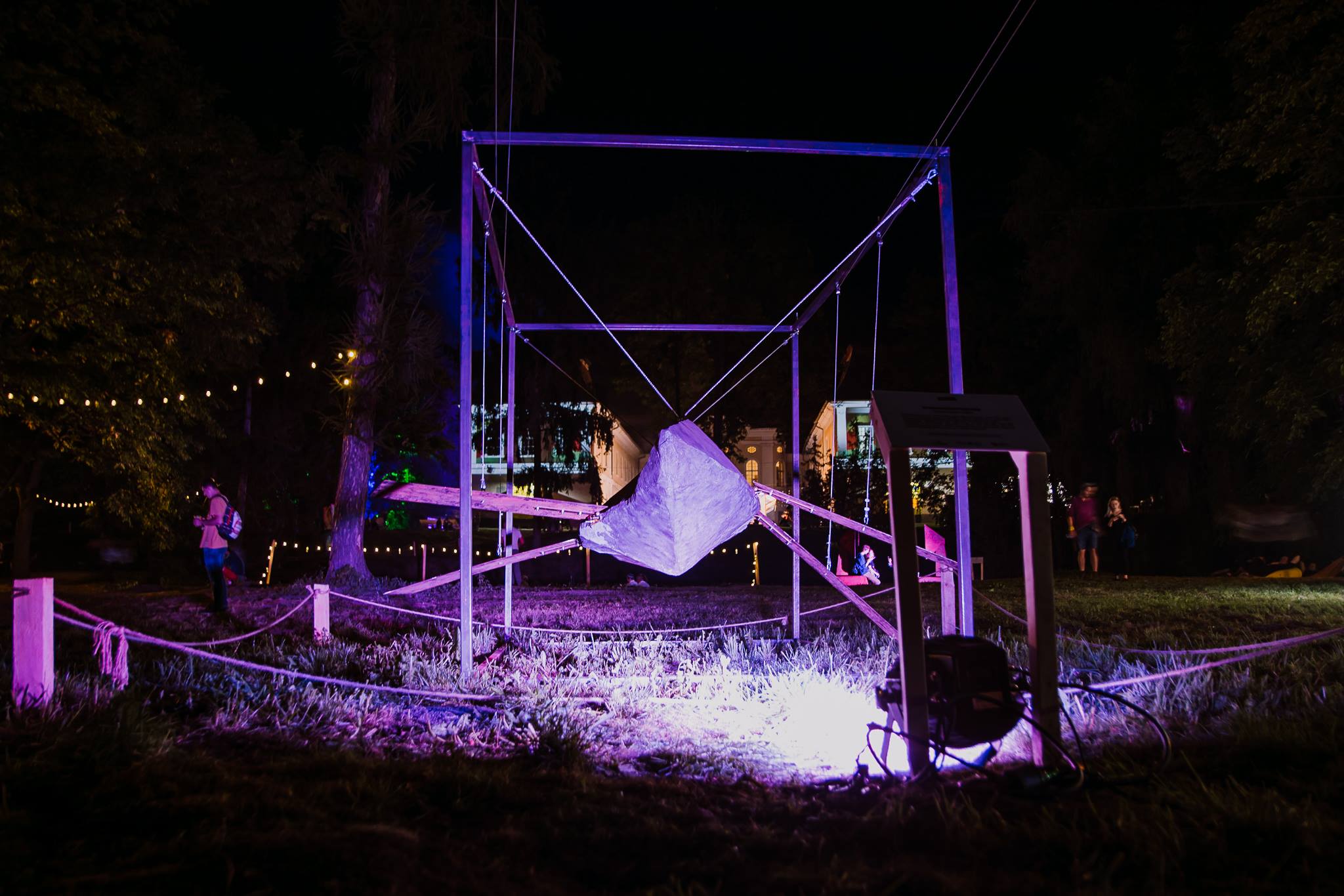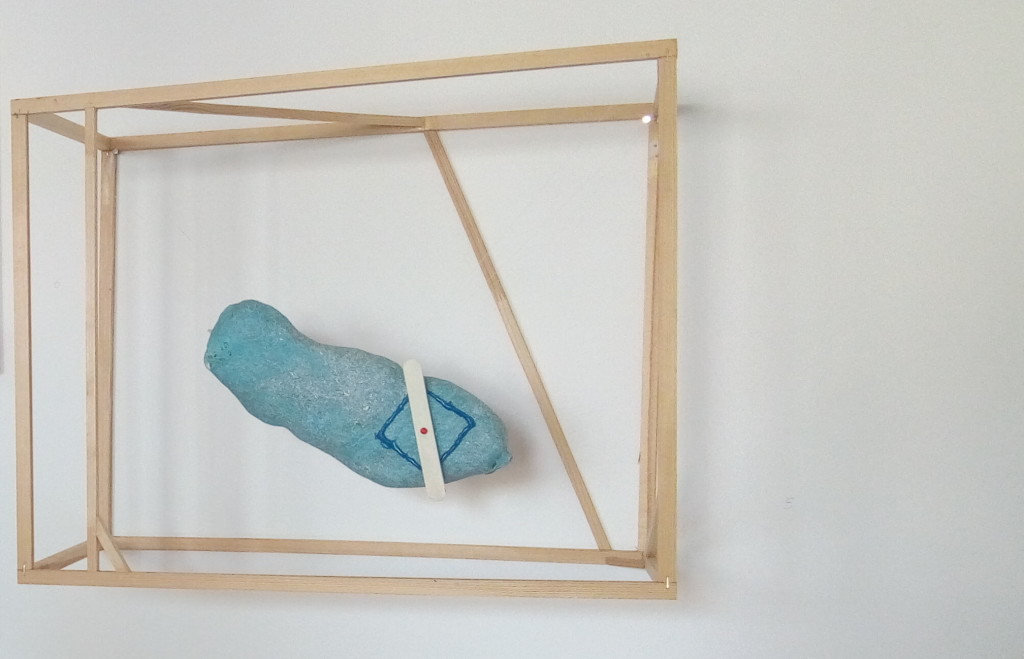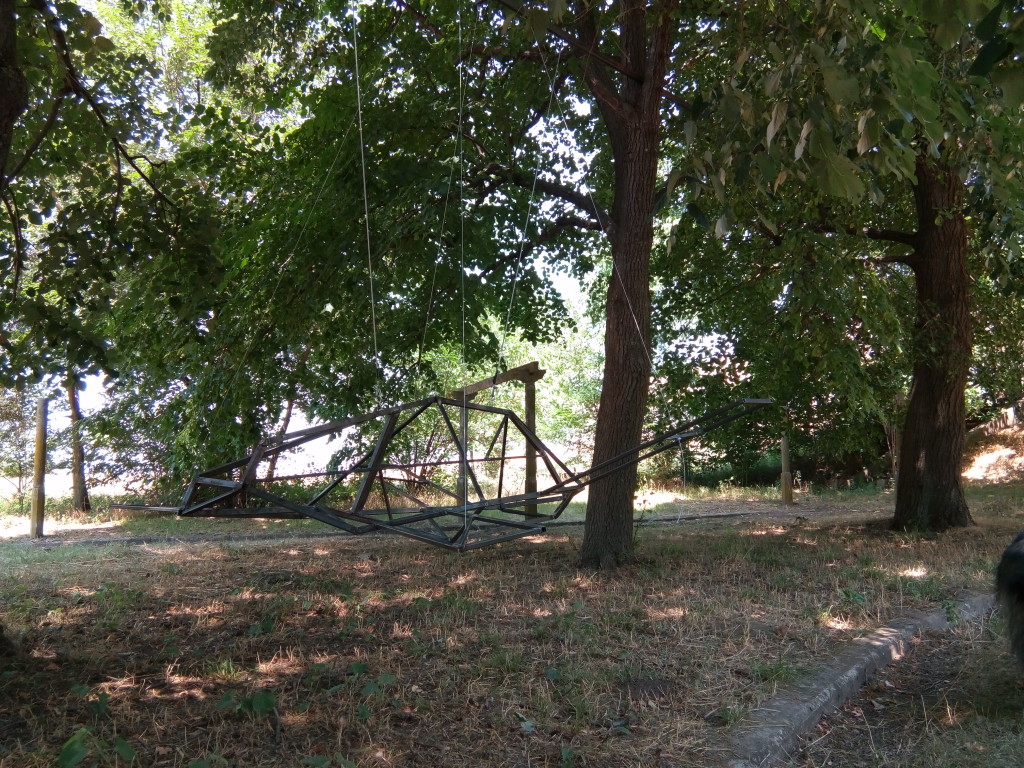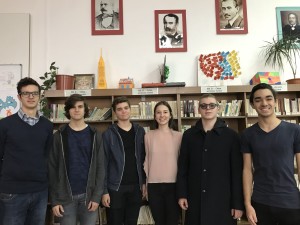Abstract: The following presentation and interview deals with the way in which a visual kinetic artist, Ștefan Radu Crețu, is contouring his unique style, as I have followed his work presented on several occasions, during festivals, art residences or exhibitions.
Keywords: visual artist, kinetic art, sculpture, art interview.
Ștefan Radu Crețu is a visual kinetic artist from Romania who keeps a close bond to natural elements whenever he creates art. He draws a sight-specific inspiration, analyzing the new space he comes into and generating art that best matches the location where it is set to be exhibited. Equally, he creates pieces that can be brought into the gallery or that can remain in an open space. For the pieces meant to remain on the walls of a room, the choice is astounding. Metal, wiring and natural materials are framed and mixed into a unique result. One of the pieces presented at the Bucharest 418 Gallery’s exhibition 9 Years of Art & Romanian Artists, when it still was activating in Bucharest, was Blue Stromatolite from 2016. It depicts the allusion of a stone, motorized with a small propeller and encased into a wooden box frame structure.
Even though, in this case, a real stone is not exhibited, it is just a step into the making of future large-scale projects changing the frame for a metal one and replacing the fiberglass stone with a real boulder. Two other pieces, present at Cetate, Dolj, during the Art in Context Project, illustrated the same allusion to the shape of a stone, its contour being drawn upon an aluminum-looking background.
2. Inside the Stone[2]
The inside part of the contour is texturized with sand and stone, fixed into place on the flat surface. The materials and the allusion to natural elements come not only from the artist’s unique philosophy, but also from his own experience of new sights and elements, many times not being the case of pristine nature, but of a rural-shaped environment, as the case was at Cetate, next to the crease of the Danube River.
Usually, the works that are created are ranging from toy-like sized to monumental installations and they can be found either on the city streets, on the city walls, in gardens, under the shade of trees, at festivals or in galleries. The astounding diversity is doubled by the amount of works produced by one prolific creator.
When deciding to exhibit in the outdoors, Ștefan Radu Crețu continued his ‘stone story’ series, may I call it so. The art piece is named Inside the Stone, once again referring to the same material, as he did for the piece exhibited at the Gallery 418.
3. Stone Age project[1]
This time, however, the stone itself cannot be glimpsed. A metal framework hovering above the ground gives off the illusion of a stone with wings flying into thin air. The carcass may draw the shape of a boulder, but the material is just metal. What is brought into the environment is not a material taken from nature, but the art-encounter and the nature-experience felt by the artist. Going beyond what is exhibited during the Cetate Arts Danube residency, the artistic project created by Ștefan Radu Crețu at Awake Festival shows his continuity.
The shape is replaced with a real boulder, to which wings are attached, and that is hovering above the earth, held in place by metal strings. The project once again, is site-specific and the exhibition space is under the shade of the trees. The sculpture from Awake Festival and Inside the Stone represent two art pieces in evolutionary connection. One suggests the framework of ideas, while the other shows the ideas transcribed into a final-stage art.
Over an interview, Ștefan Radu Crețu presented a short peak into his views and creational choices. How do you start thinking a new art piece? Is there something that inspires you, for example events from your life, traveling, music.. or is it maybe a sudden idea that pops to mind?
I choose the theme according to what enchants me at that time, according to what is new to me, but sometimes I go over some older subjects, which I try to observe from a different point of view and from this point something new comes up.
what degree do you think nature represents an inspirational source for your art?
Nature is in fact the source for everything that we make. We are a part of nature and we are imitating without understanding what it is that we see. We observe the internal structure of a metallic meteorite at the Museum of Natural History, the geometry and the fractals created on the surface resulted in some of the most complex works, concentrated in an organic shape, such as a potato’s. The microscope is another example of seeing nature as a point of inspiration. Nature is everything, not just what we generally see with our bare eyes, and then, the field of research becomes an infinite one, or more exactly, it is in the process of expanding.
What made you opt for kinetic art? Is there a reason why you prefer movement in pieces of art?
I add or not add movement to my art. It works for some and it doesn’t for some others.
I have noticed stone and metal among the materials that you choose to use. Do you think they have a certain meaning? Or maybe they represent materials that come in handy?
The materials become a challenge according to the work’s dimensions and their proportions because I combine them visually as well as functionally. The technical aspects are important because installations that have mechanical-electrical elements need to be time-withstanding. There is no precise recipe. There are simply times when the theme predominantly imposes a type of material; I use it until I am exhausting its possibilities and then I forget about it for a while and I combine it with something else, different from what I’ve done before.
At 418 Gallery, as well as at the Awake Festival or at the Cetate Estate I have seen works of this type: a stone element, caged in a metallic quadrilateral carcass, but one that is only the skeleton of a structure, not enclosed. And in both cases there was a movement-inspired element, be it a small propeller, or the wings. Why did you choose to encase the stones in a metal frame and why did you choose to connect them with movement? Is there any meaning behind your decision? Or, maybe this time, it was only something that you felt right to do?
For the first suspended works I’ve built some metal frames, that were holding the piece up with the help of metal cables with a double role, also being electrical conductors. Somehow, from these structures with a utilitarian role I have come to develop very complex structures, that have become self-standing art pieces, and I have come to create different sorts of cuboids for the suspended works. The role of the cuboid, except that of supporting the sculptural objects, has become that of representing a delimitated space, that creates a connection with the viewer, like an aquarium in which different species are exposed.
At the Cetate estate workshop there were two art pieces with a metal background, that had in the center an accumulation of earth and stones. From afar, they seemed two boulders on a shiny surface. Personally, I consider that they once again refer to one of the elements that define your art: a tuff material, attenuated and soothed down by movement and by the metal shine. Do you think these two pieces can be related to the first two mentioned earlier? Or do you think that they represent something completely different?
The works that you are talking about are a part of the project Stone Age, that I have presented at Calina Gallery in Timisoara. They belong to the same family of flying stones. They are the flat version of comets. These comets mimic flight with the help of transparent and fragile wings, which, thanks to the backgrounds reflectiveness, almost become invisible. They represent a secret mechanism through which Apocalypse is being avoided.
How do you decide the titles of the pieces and what importance does each of the art work have for you?
The title is almost always a collage of works, meant to describe, as accurate as possible the concept, becoming a hard-to-remember semi-statement.
Some of the pieces seem metal beings inspired from the shapes of insects. Would you ever be interested in creating at some point an imaginary world of ‘art creatures’?
I would like, at some point, to transpose my works into an artistic animated film, to create characters and interactions between them, where sculptures can figure out, for themselves, their own genealogic evolution.
Article by: Gabriela Robeci
Photo by:
[1]Photo by: Gabriela Robeci, taken at 418 Gallery, Bucharest, with the consent of the gallery
[2]Photo by: Gabriela Robeci, taken at Cetate Estate, 418 Gallery, with the consent of the gallery
[3]Photo by: Gabriela Robeci, taken at the Cetate Estate, 418 Gallery, with the consent of the gallery
[4]Photo by Petru Cojocaru, taken at Awake Festival, with the consent of Awake Festival organizers






